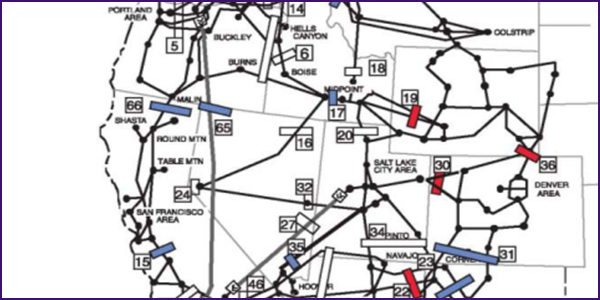WECC’s new Path Task Force (PTF) on Wednesday kicked off an effort to examine the role of existing transmission path rating procedures in Western Interconnection planning and operating processes and whether they are still applicable to a changing grid.
The regional entity’s Joint Guidance Committee (JGC) authorized creation of the PTF in September to identify the “relevance and role” of total transfer capability (TTC), path ratings and the “three-phase” ratings process in both the operations and planning horizons for industry participants. (See New WECC Task Force to Examine Path Rating Processes.)
The three-phase process is designed to address planned new transmission facilities and the upgrading or rerating of existing facilities through a review group consisting of project sponsors and representatives of other systems that could be affected by the project, according to WECC.
The path rating process provides transmission project sponsors with the means to obtain an “accepted” rating that meets the RE’s criteria and NERC reliability standards.
During the PTF’s kickoff meeting Wednesday, WECC Director of Reliability Risk Management Vic Howell, the staff liaison to the task force, added some flesh to the mission, explaining the stakeholder group will also “identify and explain the changes in regulatory, markets and business practices, as well as changes in operations in planning that support [the PTF’s] conclusions and recommendations.”
Those findings will be reported to the JGC, although the PTF will also give presentations to WECC’s Operating Committee (OC) and Reliability Assessment Committee, Howell said.
Howell said the idea for the PTF originated in July after the Western Area Power Administration gave a presentation on an internal project to more dynamically calculate near-term and real-time TTCs to be posted on its Open Access Same-Time Information System (OASIS), rather than relying on seasonal TTCs.
“That led to some discussions of the shortcomings of too much reliance on seasonal TTC values,” Howell said. “And as we talked about it at the OC meeting and the joint standing committee meetings, there were a lot of questions and discussions about the use of total transfer capability in the operations and the planning horizon, and the discussion led to asking, ‘How does the path rating fit into this whole equation? And where does the three-phase ratings process come into play?”
Howell lauded the professional diversity of the 12-member task force.
“We wanted to make sure that as we choose members for this task force, we get representation from operations, that we get expertise from planning and … from business practices — scheduling and markets and things of that nature,” he said.
Members Speak
In a get-acquainted exercise, Howell asked PTF members to describe their interest in the path ratings issues.
“The one thing that really stands out is tackling this time frame issue that’s come up,” said PTF Chair Matthew Veghte, an engineering supervisor at WAPA.
“We don’t just look at [the power system] from a seasonal perspective or a next-day perspective; we’re looking at all the way from planning — which can be five years, to a year, to six months to 30 days out — to one day out,” Veghte said. “We have all these different time points that have different things going on, and we’re tasked with, ‘How do we figure out TTC with that?’”
Transmission planning consultant Chifong Thomas said she was interested in exploring how to apply planning restrictions to the operating world in a way that’s not “overly restrictive.”
“Because things change when you go from planning to operations, and so how do we communicate the information that was important to help the operating system,” Thomas said.
Gary Trent, transmission planning manager at Tucson Electric Power, cited the fact that his utility will be joining the Western Energy Imbalance Market in spring 2022 while also transitioning to NERC’s MOD-30-02 flowgate methodology for calculating short-term transfer capability.
“I believe that we’re going to see more and more companies heading that way as time moves on, and being able for us to be on the ground here with that is going to help us all out,” Trent said.
Hari Singh, principal engineer at Xcel Energy, said his interest stems from his view that there is “quite a bit of intersection” between the concepts of transfer capability and system operating limits.
“Now whether we say that system limit is for the operations horizon or the planning horizon, I don’t see why they should be very different if the system we’re looking at five years out in the planning horizon is almost the same as what we’re operating today,” Singh said. “I guess I’m certainly very interested in trying to de-mystify this concept of path ratings we’ve had in WECC and how it relates to total transfer capability and system operating limits.”
Audrey Stevenson, operations planning engineer at Bonneville Power Administration, said, “I think the thing I’m most excited about this task force is identifying and trying to reconcile the differences that are present between the performance requirements and planning horizon, which lead to path ratings and operating horizons, which lead to the short-term TTC and also exceedance identification.”
The task force also includes Dede Subakti and Larry Bellnap of CAISO; Brenda Ambrosi of BC Hydro; Peter Mackin of GridBright; Igor Kormaz of Tri-State Generation and Transmission Association; Clint Savoy of SPP; and Bill Shemley of PacifiCorp.



